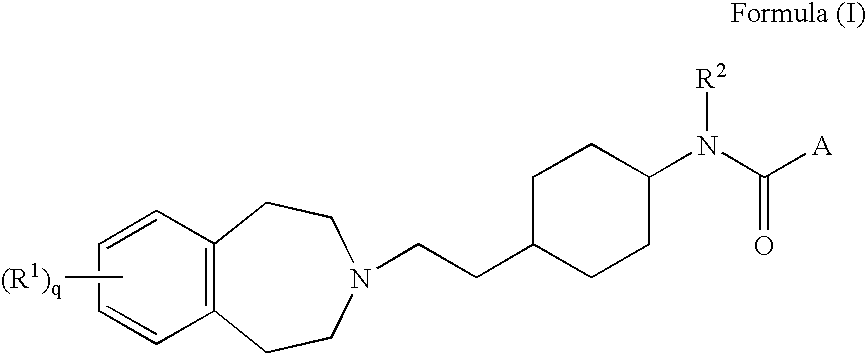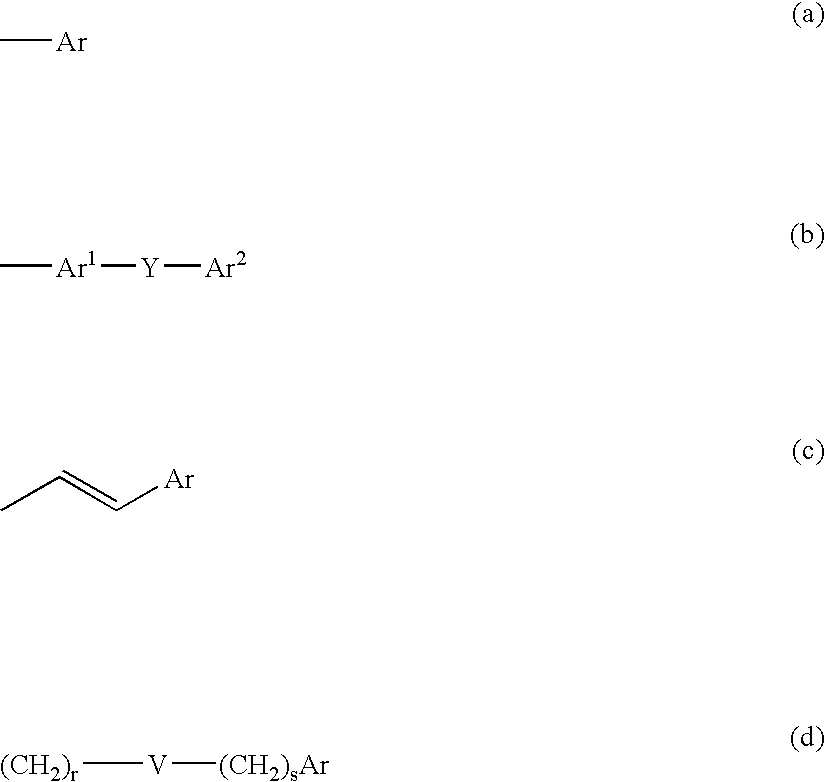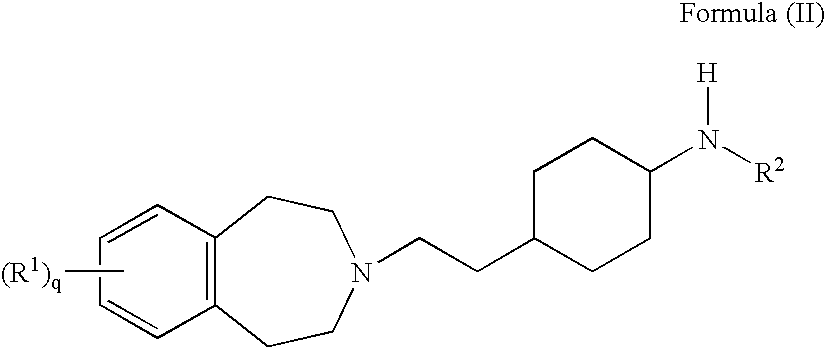M3 muscarinic acetylchoine receptor antagonists
a technology of muscarinic acetylchoine and receptor, which is applied in the field ofthiazole aniline compounds, can solve the problems of anti-muscarinic compounds in us
- Summary
- Abstract
- Description
- Claims
- Application Information
AI Technical Summary
Benefits of technology
Problems solved by technology
Method used
Image
Examples
example 12
trans-(E)-7-Cyano-3-(2-(1-(4-(3-(4-fluoro)phenylpropenoyl)amino)cyclohexyl)ethyl)-2,3,4,5-tetrahydro-1H-3-benzazepine
[0315] A mixture of trans-3-(2-(1-(4-amino)cyclohexyl)ethyl)-7-cyano-2,3,4,5-tetrahydro-1H-3-benzazepine (103 mg, 0.35 mmol), 4-fluorocinnamic acid (58 mg, 0.35 mmol), 1-(3-dimethylaminopropyl)-3-ethylcarbodiimide hydrochloride (67 mg, 0.35 mmol), and 1-hydroxybenzotriazole (20 mg, 0.15 mmol) in dichloromethane (8 ml) was shaken at room temperature for 16 h. The reaction mixture was washed with saturated sodium bicarbonate (4 ml). The resulting precipitate was collected by filtration, washed with water (2×10 ml), and dried to give the title compound (87 mg, 56%) as a colourless solid.
[0316] Mass spectrum (API+): Found 446 (MH+). C28H32FN3O requires 445.
[0317]1H NMR (DMSO-d6) δ: 0.94-1.31 (8H, m), 1.81 (4H, m), 2.40 (5H, m), 3.04 (4H, m), 3.63 (1H, m), 6.54 (1H, d, J=16 Hz), 7.32 (4H, m), 7.59 (4H, m), 7.99 (1H, d, J=8 Hz).
example 13
trans-7-Cyano-3-(2-(1-(4-(3-pyrrolo[2,3-b]pyridyl)carboxamido)cyclohexyl)ethyl)-2,3,4,5-tetrahydro-1H-3-benzazepine
[0318] A mixture of trans-3-(2-(1-(4-amino)cyclohexyl)ethyl)-7-cyano-2,3,4,5-tetrahydro-1H-3-benzazepine (103 mg, 0.35 mmol), 3-pyrrolo[2,3-b]pyridyl carboxylic acid (56 mg, 0.35 mmol), 1-(3-dimethylaminopropyl)-3-ethylcarbodiimide hydrochloride (67 mg, 0.35 mmol) and 1-hydroxybenzotriazole (20 mg, 0.15 mmol) in dichloromethane (8 ml) was shaken at room temperature for 16 h. The reaction mixture was washed with saturated aqueous sodium bicarbonate (4 ml). The resulting precipitate was collected by filtration, washed with water (2×10 ml) and dried to give the title compound (81 mg, 0.18 mmol, 53%) as a colourless solid.
[0319] Mass spectrum (API+): Found 442 (MH+). C27H31N5O requires 441.
[0320]1H NMR (DMSO-d6) δ: 1.02 (2H, m), 1.15-1.45 (6H, m), 1.81 (4H, m), 2.50 (5H, m), 2.91 (4H, m), 3.73 (1H, m), 7.14 (1H, m), 7.32 (1H, d, J=8 Hz), 7.57 (2H, m), 7.73 (1H, d, J=8 Hz...
example 14
trans-7-Cyano-3-(2-(1-(4-(3-(3-(5-methyl)-1,2,4-oxadiazolyl)benzoyl)amino)-cyclohexyl)ethyl)-2,3,4,5-tetrahydro-1H-3-benzazepine
[0321] A mixture of trans-3-(2-(1-(4-amino)cyclohexyl)ethyl-7-cyano-2,3,4,5-tetrahydro-1H-3-benzazepine (103 mg, 0.35 mmol), 3-(3-(5-methyl)-1,2,4-oxodiazolyl)benzoic acid (71 mg, 0.35 mmol), 1-(3-dimethylaminopropyl)-3-ethylcarbodiimide hydrochloride (67 mg, 0.35 mmol) and 1-hydroxybenzotriazole (20 mg, 0.15 mmol) in dichloromethane (8 ml) was shaken at room temperature for 16 h. The reaction mixture was washed with saturated aqueous sodium bicarbonate (4 ml). The organic layer was pipetted onto a 10 g pre-packed silica column and eluted with 30-100% ethyl acetate in hexane. The fractions containing the title compound were combined and evaporated in vacuo to give the title compound (119 mg, 71%) as a colourless solid.
[0322] Mass spectrum (API+): Found 484. C29H33N5O2 requires 483.
[0323]1H NMR (CDCl3) δ: 1.08-1.35 (5H, m), 1.45 (2H, m), 1.84 (2H, m), 2.1...
PUM
| Property | Measurement | Unit |
|---|---|---|
| pressure | aaaaa | aaaaa |
| temperature | aaaaa | aaaaa |
| temperature | aaaaa | aaaaa |
Abstract
Description
Claims
Application Information
 Login to View More
Login to View More - R&D
- Intellectual Property
- Life Sciences
- Materials
- Tech Scout
- Unparalleled Data Quality
- Higher Quality Content
- 60% Fewer Hallucinations
Browse by: Latest US Patents, China's latest patents, Technical Efficacy Thesaurus, Application Domain, Technology Topic, Popular Technical Reports.
© 2025 PatSnap. All rights reserved.Legal|Privacy policy|Modern Slavery Act Transparency Statement|Sitemap|About US| Contact US: help@patsnap.com



